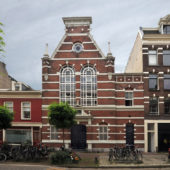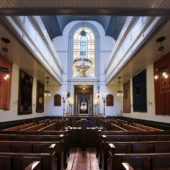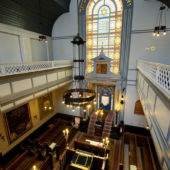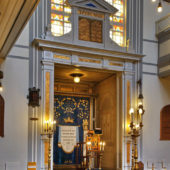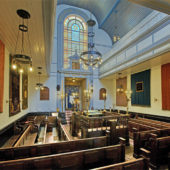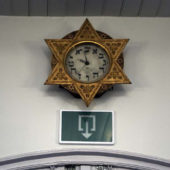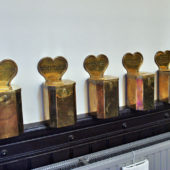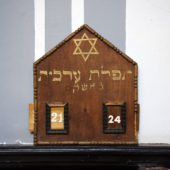The oldest functioning Ashkenazi synagogue in Amsterdam, nestled between two row-houses on the narrow Gerard Dou street, the synagogue remained unnoticed by the Nazis during World War II. Due to the watchful eyes of its neighbours, the building survived the war.
Toward the end of the 19th century, many Jews moved out of the run down Jewish quarter of Amsterdam and moved into the new working-class neighborhood of The Pipe (De Pijp). In 1886 these Jews formed a society called “Teshungat Israël” (Help of Israel). By 1892 Teshungat Israël was able to build a synagogue on Gerard Dou Street. Until World War II the Synagogue flourished. It was known as a place where rabbis and intellectuals prayed together with laborers and met together for study. Daily services were well-attended and the Synagogue maintained an active program of study for its members.
The Gerard Dou Synagogue’s last service prior to the Holocaust was on Rosh Hashana 1943. Because the Synagogue is nestled between two row houses on narrow Gerard Dou Street, it was not recognized by the Nazis as a Jewish house of worship and thus emerged from WWII unscathed. The same cannot be said of the synagogue’s congregation, few of whom survived the Holocaust. The first Jewish prayer service in Holland after WWII was in Gerard Dou Synagogue on the second Shabbat after Liberation Day, May 5, 1945. At that time, it was the only Ashkenazi synagogue in all of Amsterdam that could be used.
Today, Gerard Dou Synagogue is the oldest functioning Ashkenazi synagogue in Amsterdam. Regular Orthodox services are held on Shabbat and holidays and the Synagogue has its own rabbi and cantor. At the end of the 1990s the Synagogue was thoroughly restored and returned to its original condition. In 1998 Mecham Sebbag was appointed Youth Rabbi in charge of the young peoples’ program – the only such rabbi in all of Netherlands. With his arrival, the Synagogue gained increased notoriety. The traditional Dutch Jewish melodies and rituals, the beautiful, recently restored interior and cozy atmosphere make services at the Synagogue exceptional. First-time visitors feel warmly welcomed and young people are attracted to the services. Each individual is important to the welfare of the community. The newly renovated community center is used for communal Seders, Sukkot dinners, and other community events.
The exterior of Gerard Dou Synagogue is Victorian, featuring red brick with white horizontal stripes and molding. Two tall, arched paned windows are placed above the entranceway, with a round Star-of-David window above them. Inside the prayer room, cream walls lined with banners and wood floors introduce an intimate atmosphere. In the east wall there is a large arched stained glass window with molding around it, inscribed and gilded in Hebrew. Below the window is the Aron Kodesh, classically styled with pilasters supporting the crosshead and pediment, which display two gold tablets inscribed with the Ten Commandments in Hebrew. The Aron Kodesh is highlighted with gold and its interior “room” is entirely gold, wherein religious symbols have been inscribed into the walls. The bimah is situated in the center of the prayer room, with a wood balustrade around the front and sides, with a large tivah (reader’s desk) in it, draped with a blue and gold velvet throw. Chandeliers and “electric candlesticks” light the room. The women’s gallery is upstairs and runs along both sides and the back of the sanctuary. Elegant, simply carved wood pews fill the sanctuary.

